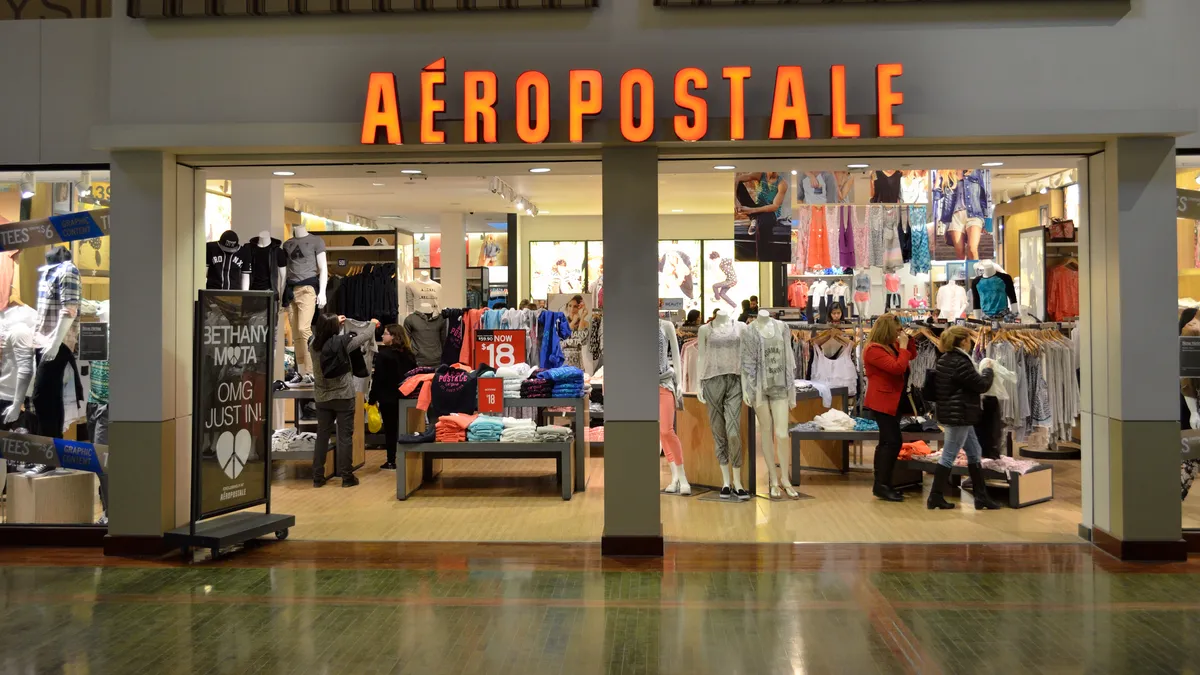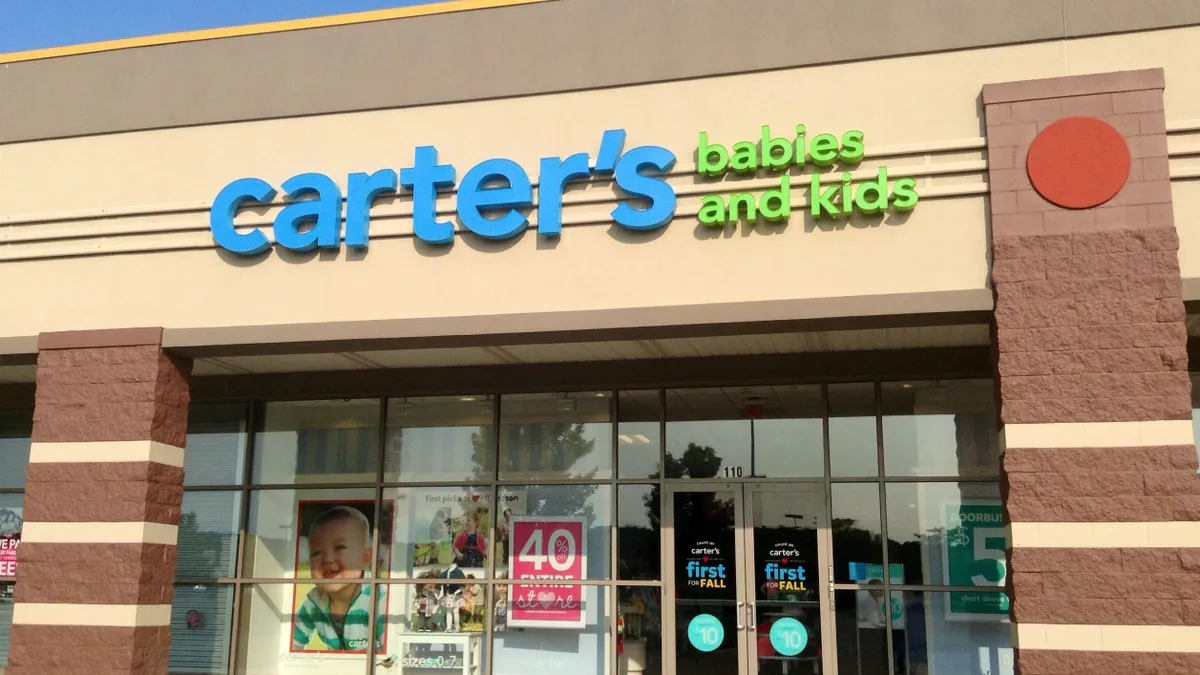Aeropostale was once a high flyer. Twenty-three years after parent company Macy's opened the first Aeropostale location in Los Angeles' Westside Pavilion Mall, the teen apparel chain reached its zenith in 2010: Sales soared to $2.4 billion, and its stock price ascended to an all-time peak of $32.24 per share.
Then the bottom dropped out. Like American Eagle Outfitters and Abercrombie & Fitch, its chief rivals in the teen apparel space, Aeropostale saw its logo-centric clothing fall out of favor. Increased competition from fast fashion brands and declining mall traffic also took their toll, and in 2015, Aeropostale's annual sales plummeted to $1.5 billion. After 13 consecutive quarters of losses, Aeropostale filed for Chapter 11 bankruptcy protection in early May, announcing store closing sales at 113 of its U.S. locations as well as 41 stores in Canada.
Experts tell Retail Dive that Aeropostale sealed its fate by hewing too closely to trends set by the so-called "other two As'"—especially Abercrombie & Fitch, which under then-CEO Mike Jeffries virtually defined teen fashion in the previous decade—and failed to develop a vision of its own. That’s made it difficult for Aeropostale to pivot, because essentially, there’s not much of a fulcrum.
Equally problematic, Aeropostale hasn’t found a way to sell apparel without massive, margin-killing discounting, further dimming its prospects for post-Chapter 11 survival, Shelley E. Kohan tells Retail Dive.
“I think it’s going to be a struggle for them unless they quickly define a better specific target market and rethink their margin problem,” said Kohan, VP of retail consulting at store analytics firm RetailNext. “When you have razor-thin margins, you cannot expense your way into a profit, and that’s always going to be a challenge for them. And they’re going to have to figure that out.”
The real problems
Macy’s originally launched Aeropostale as a string of specialty stores operated outside of its department stores, positioned as an answer to Banana Republic. Rather than copying Banana Republic’s World War II-era safari vibe, Aeropostale adopted a 1940s French colonial aviator style. Mark S. Handler, Macy's president at the time, told the L.A. Times that Aeropostale wouldn’t be marked too indelibly by any one style: "The decor has a strong theme to it, but if you look at the clothes, those will change as fashion or preferences change,” he said.
Macy’s eventually sold the Aeropostale subsidiary to global investment bank Bear Stearns, which took it public in 2002. Along the way, the retailer did indeed lose its French aviator theme and instead began to feature merchandise that closely resembled that of American Eagle and Abercrombie, becoming a fixture in malls and a favorite of the teens who shopped there.
Aeropostale (which at press time hadn't reponded to requests for comment for this story) lays much of the blame for its current predicament at the feet of partner MGF Sourcing, a clothing manufacturer and supply chain management company owned by Sycamore Partners, the private equity firm that acquired 8% of the company in 2013. According to the Wall Street Journal, Aeropostale alleged that MGF's moves to impose stricter payment terms forced the retailer to file Chapter 11, charges that MGF called "frivolous." (The companies subsequently agreed to a settlement.)
While there may be some truth to Aeropostale’s contention that MGF’s terms led it to where it is today—in bankruptcy court and off the New York Stock Exchange—the reality is that the retailer’s troubles were becoming evident by 2013, when teen apparel sales nosedived. Like many other merchants, Aero has struggled to figure out how to appeal to today's teenagers, who are more likely to spend their limited cash on going out to eat or other experiences.
“These fashion brands, particularly the brands doing business with young people, are dealing with generational change,” Columbia University business school retail studies professor Mark Cohen told Retail Dive. “The fashion space is completely unforgiving, and you’ve got to cut your bones every season. You have to be fastidious about quality and size. All of these fashion brands become increasingly unstable over time. The creative juices dry up, whether it’s an individual or a team—they lose their focus. The magic is easy to talk about, but not so easy to deliver. There’s also an element of fragility because of the unwillingness of an audience to affiliate with a brand for a longer term. We fall out of love with things.”
Even worse, while Aeropostale says it sells “casual apparel and accessories, principally targeting young women and men,” its merchandise seems pegged to younger kids—tweens, even, and not the older teens and college students that are drawn to American Eagle and Abercrombie. And that means ignoring Aeropostale's real consumer: The parents that actually purchase its clothing, Kohan says.
“Aeropostale had this really strong brand in early 2000, but once the hoodies and graphic tees went out of style, Aero didn’t find a replacement strategy,” Kohan told Retail Dive. “Today Aero is all about price. They have this kind of junior customer who's not quite a fast-fashion customer, where Mom’s the real shopper, taking the 11-year-old into the store. So if that trend is off or too sexy for this kid, Mom’s not going to be buying that. So I think they’re missing the trend for that market.”
Still another factor pressuring Aeropostale is that the quality of its clothing is high—something that should be a selling point—but its prices are low. That’s an equation that just literally won’t add up, Kohan says, and could further confuse the issue of who shops there.
“One of the things for Aeropostale is they’ve always talked about quality, and I think they do have good quality, so that margin has to be very tight," Kohan said. "And I’m not sure that today’s consumer is looking for quality. I think they’re looking for quick trends. They’re not customers for life.”
Fast fashion is here to stay
Aeropostale, American Eagle and Abercrombie did well for decades emblazoning their logos onto hoodies and t-shirts, then charging young people top dollar for the privilege of advertising their wares. But just as teens and young adults began to tire of those clothes, in came fast fashion and its inexpensive, on-trend, always-changing stuff.
Spanish apparel maker and retailer Zara (or more accurately, its parent company, Inditex) is credited for starting the fast fashion phenomenon. From the beginning, Zara has kept a close eye on the latest fashions, churning out clothes in small batches so that it is always ready to flood its stores with another wave of au courant merchandise. The company develops 10,000 new items each year, and has perfected the process of getting apparel from the runway to the rack in record time.
That approach caught on, well, fast. These days, the segment is crowded with fast-fashion retailers like H&M, Forever 21, Uniqlo, Bebe and even limited-edition offerings by Target. And the list is getting longer.
Two years ago, in an "If you can't beat 'em, join 'em" maneuver, Abercrombie & Fitch announced it was taking its Hollister brand into fast fashion, making changes to speed up its supply chain, revamping products and lowering prices. Old Navy made similar moves under previous brand chief Stefan Larsson, who has fast-fashion experience. Aeropostale has not followed their lead.
There are some small indications that fast fashion, which a decade ago was an innovation that has transformed apparel retail, may be due for some alterations, namely in quality and sustainable manufacture amid concerns about environmental impact and unsafe working conditions in overseas factories. Even fast-fashion mainstay H&M in recent years brought its higher-end, higher-quality COS stores to the U.S.
But in bad news for Aeropostale's post-Chapter 11 prospects, most indications are that “fast fashion is here to stay,” said Hongwei Liu, CEO/co-founder of Mappedin, an indoor wayfinding platform for premium North American malls. Kohan agrees, and said that fast fashion retailers will continue to “take spending away from the three As.”
Understanding the target market, beyond “teen”
For Aeropostale and its competition to recapture their former glories, they must understand their core customers and what they want, a process that not only involves sussing out which age groups actually shop there, but also identifying other key demographics and their tastes, Kohan says.
“Hispanics are a very big market, for example, and if you’re not recognizing that they’re a big part of the target, you're missing out on a lot of things, including sizing opportunities,” she said.
Survival—not just for Aeropostale, but also for American Eagle, Abercrombie and beyond—might mean a significant shift in leadership, say both Kohan and Cohen. That could mean turning more to younger people in leadership positions because of their digital savviness and as well their willingness to speak the truth, even to the bigwigs in the organization, says Kohan.
“These college grads coming out have more skills and experience than we ever did,” Kohan said. “They have this aura about them when they hit the market. They have no qualms—they will tell you their opinion—they’re really smart about that. They can spot things, and there’s no status difference to them. They lack experience, and maybe some ability to connect dots. But they want to add valuable contributions to the business, and that’s what makes this leadership coming up so strong.”
Cohen agrees that leadership is missing at Aeropostale, though he says that's true of all three As. Still, while the teen retailers are all still in turnaround mode, there are clear signs that two of the three are making some critical adjustments. American Eagle has been able to depend on the strength of its jeans business as it brings higher quality and more appealing merchandise into stores. Even Abercrombie has managed to hang on as it tries to figure out what exactly will replace the sexually-charged, exclusivity-based branding of the Jeffries era.
That leaves Aeropostale the odd brand out... maybe not for too much longer, however.
“Aeropostale has always been the weak link in the chain," Cohen said. "They never had a signature collection in terms of denim like Eagle, and they never had the presence within the consumer space like Abercrombie. It’s all about low price, and they can’t protect themselves from themselves. The lights start to dim and they go out, and they don’t come back on. My guess is there’s no 'there' there, and they’ll have terrible trouble coming out of Chapter 11 intact.”





















